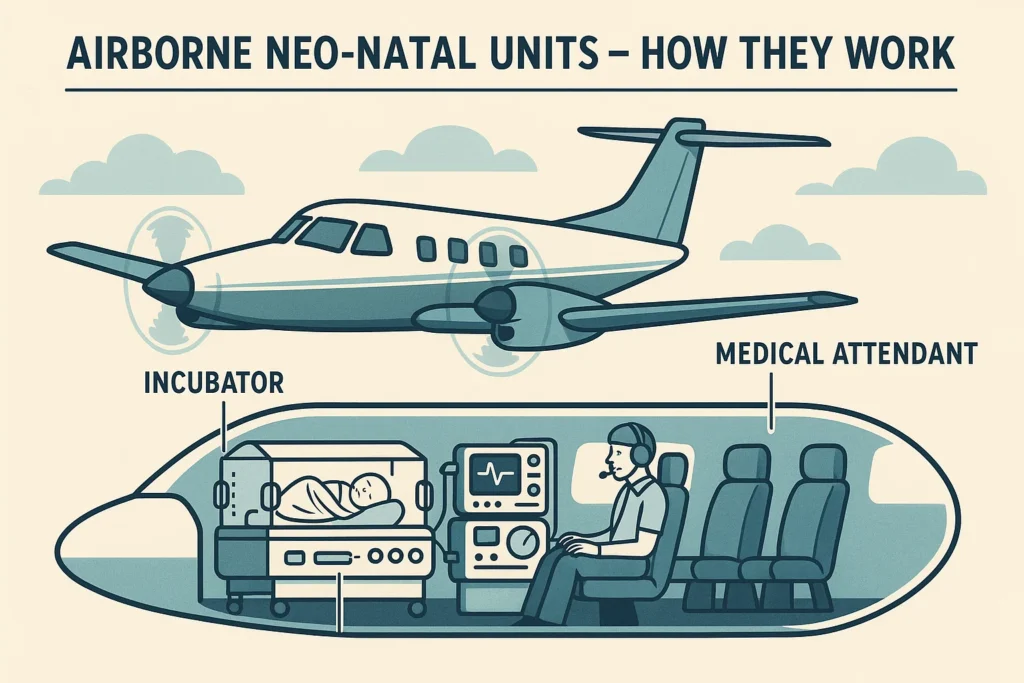👶 Airborne Neo-Natal Units – How They Work to Save Tiny Lives
Discover how airborne neo-natal units work in India. Learn how DreamSafar.in transports newborns with incubators, ventilators, and ICU care in helicopters.
🚁 Introduction: When Minutes Matter for Newborns
Newborn babies born prematurely or with life-threatening complications often need to be transferred urgently to NICU-equipped hospitals—but ground transport is too slow or unsafe in many parts of India. That’s where airborne neo-natal units come in.
These specially equipped helicopters and aircraft are designed to provide full neonatal ICU care mid-flight, offering fragile infants their best chance at survival.
At DreamSafar.in, we’re proud to operate India’s few airborne neo-natal units, designed to meet the needs of newborns who can’t afford to wait.
🧠 Airborne Neo-Natal Units – How They Work
✅ 1. Specialized Aircraft Configuration
-
Helicopters or fixed-wing aircraft are reconfigured to house a neonatal ICU
-
Key features include:
-
Shock-absorbing stretcher mountings
-
Silent cabin space to reduce noise-induced stress
-
Quick access ports for medical tubes and wiring
-
✅ 2. Neonatal Transport Incubator
-
Temperature-controlled
-
Equipped with ventilation, humidity, and oxygen controls
-
Prevents hypothermia, hypoxia, and shock during flight
✅ 3. Portable Neonatal Equipment Onboard
| Equipment | Purpose |
|---|---|
| 👶 Neonatal ventilator | For babies with breathing difficulty |
| 🧪 Multiparameter baby monitor | Tracks oxygen, heart rate, BP, and temperature |
| 💉 Infusion pumps | For IV nutrition or antibiotics |
| 🚼 Phototherapy lights | For neonatal jaundice (in longer transfers) |
✅ 4. Specialist Medical Crew
-
Neonatal ICU nurse trained in:
-
CPR for infants
-
Incubator management
-
Handling oxygen/air mix ratios
-
-
Pediatrician or neonatologist on board for high-risk missions
🌍 Real Example – How DreamSafar.in Airlifted a Critical Neonate
Location: Malda, West Bengal
Baby: 4-day-old premature newborn with respiratory distress
Challenge: No NICU within 200 km; road conditions poor due to monsoon
Action: DreamSafar.in launched its neonatal unit helicopter in under 4 hours
✅ Baby placed in temperature-stable incubator
✅ Oxygen and medication administered mid-air
✅ Arrived at Kolkata NICU hospital in 80 minutes
Result: Baby stabilized and recovered in 5 days—saved by airborne care.
🧾 When Are Airborne Neo-Natal Units Needed?
-
Premature birth (<32 weeks)
-
Neonatal jaundice requiring phototherapy
-
Low birth weight (<1.5 kg) with poor vitals
-
Congenital defects needing urgent surgery
-
Breathing disorders like IRDS (Infant Respiratory Distress Syndrome)
💡 Benefits of Airborne Neo-Natal Units
-
🕒 Time-saving: Cuts travel time from hours to minutes
-
🩺 Constant monitoring: Full ICU-level data in real-time
-
❄️ Stable conditions: No exposure to outside temperature changes
-
👨⚕️ Expert crew: Immediate intervention in emergencies
❓ FAQ – Airborne Neo-Natal Units – How They Work
❓ Is it safe to fly a newborn baby?
Yes, if properly stabilized in an incubator and monitored by trained neonatal staff. DreamSafar.in follows DGCA + NICU protocols.
❓ Can both parents travel with the baby?
Usually, only one attendant is allowed based on aircraft space and medical setup.
❓ What is the cost of a neonatal helicopter transfer?
Costs range from ₹2.5 to ₹6 lakh, depending on distance, crew, ICU setup, and urgency. CSR and NGO support may apply.
🔗 Useful Links – DreamSafar.in
🌐 Resources
🏷️ Tags
airborne neo-natal units – how they work, DreamSafar.in, neonatal helicopter India, NICU airlift, premature baby air ambulance, neonatal ICU helicopter, newborn transport India


